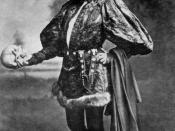From the appearance of the Ghost at the beginning of the play to the deadly conclusion, the notion of death is constantly visited. Hamlet's encounter with the gravedigger serves as a forum for Shakespeare to elaborate on the nature of death and as a turning point in Hamlet's character. In Hamlet, the gravedigger and changing mood of the encounter serve to move Hamlet and the reader closer to the realization that death is inevitable and universal.
The encounter is essential to the plot, in that it provides for Hamlet's return from England and sets the stage for Hamlet's discovery of Ophelia's death. It brings Hamlet from the state in which he was able to easily arrange for the deaths of Rosencrantz and Guildenstern to one in which he can feel deep sorrow at the loss of Ophelia. It further grants him a better perspective on the nature of death and on his own fate.
Its sharp focus on death further serves to prepare the audience for the conclusion of the play. Up to this point, Hamlet has been an active agent in trying to fulfill his destiny as prescribed by his father's ghost. His actions were disorganized and his goal continually foiled. For example, his attempt to control the situation renders him incapable of killing Claudius when he is at prayer, since Hamlet wishes to manipulate the circumstances of Claudius' death so that he is "about some act that has no relish in't" (III, iv, 91-2). The lesson of the graveyard is that death is inevitable, not contrived. Having learned this lesson, Hamlet is a more passive agent of his own fate and the plot resolves itself. The focus on the inevitability of death, which Hamlet reflects upon in the encounter with the gravedigger, enables him to embrace whatever fate will bring. Without this encounter, Hamlet would not have the perspective to tell Horatio "If it be now, 'tis not to come - if it be not to come; it will be now - if it be not now, yet it will come - the readiness is all" (V, ii, 223-5).
The scene of the gravedigger shows that death happens to everyone regardless of his status in society. As the two gravediggers are preparing Ophelia's grave, they discuss the inappropriateness of Ophelia being buried in a Catholic cemetery after she killed herself. The first clown, when speaking on the nature of Ophelia's death describes it as "in her own defense"(V, i, 7) He further mocks the occasion by saying, "But if the water come to him and drown him, he drowns not himself, argal, he that is not guilty of his own death shortens not his own life"(V, i, 198-200). It was against Church doctrine for suicides to be buried in this way. It is only because of her connections to people with power that she is allowed a Christian burial. Although it may seem that the wealthy can bypass the ramifications of suicide, everyone meets the same fate. Death, unlike the wealthy and powerful in Elsinore, does not make exceptions. Although Ophelia has avoided the embarrassment of a suicide burial, she cannot avoid death. Also, the gravedigger says that the grave is for "one that was a woman, sir, but rest her soul, she's dead"(V, i, 135-136). In death, there are no distinctions such as wealth, or even gender. Death eliminates any distinguishing characteristics of an individual just as death does not distinguish between the wealthy and poor, or male and female. Death is the great equalizer among all.
Furthermore, the characterization of the gravedigger as a witty, humorous person further conveys the universality of death. The gravedigger spends his life surrounded by death, by the disintegrating remains of his friends and companions. And what does he do? He sings, he jokes and he turns what he has into a joyous acceptance of the world. He does not fear death, but uses his humor to transform the horror of his surroundings into an affirming human experience. His humor is superior to Hamlet's. In a sense, the gravedigger is analogous the role of the jester in the royal court. He acts as a truth-teller to Hamlet. Although the gravedigger uses a play-on-words to inform Hamlet whom the grave is for, he does so truthfully. Since the gravedigger does not know it is Hamlet he is speaking to he is not restrained by the restrictions placed on him by society just as a jester is not restrained by social standing in the royal court because he is seen as a fool. The juxtaposition between Hamlet and the gravedigger shows the difference between a "fake" fool and a professional fool. The gravedigger uses his humor to deal with his surroundings. However, the reason for Hamlet's buffoonery is not completely known.. Just as the jester can say as he pleases without consequence, Hamlet plays the fool so he can get away with what he says.
In addition, the encounter with gravedigger allows Hamlet to reflect on the inevitability of death. While observing the gravedigger at work he speculates on the fates of anonymous politicians, courtiers, nobility, lawyers and land-buyers. There is no personal connection with these dead. His musing is purely intellectual and ironic. His mood is one of wonderment and a vague sense of pity, but in a detached way. He notes the common gravedigger striking a noblewoman's skull and comments "here's a fine revolution" (V, i, 92). He even mocks the "great buyer of land" by identifying him with "sheep and calves" for trusting in written bills of sale (V, i, 106; 118). He apparently fails to notice the irony of his own speech when he says that the lawyer was one who might "circumvent God" (V, i, 81). The lawyer's rhetorical skill apparently did not allow him to bypass death in the end. Hamlet's comic exchange with the gravedigger in lines 120-183 likewise shows no empathy for the dead as they discuss the various properties of the corpses of tanners and syphilis victims. It does not matter what someone did while they were alive because they end up as skulls and bones that even fools can ridicule.
Also, the gravedigger brings Hamlet closer to death by introducing the skull of Yorick. Yorick's skull does not belong to some anonymous lawyer, but to his childhood friend. Suddenly, Hamlet takes an interest in the dead that was not present in his intellectual repartee with the gravedigger. The difference between these other bones and Yorick's skull is clearly shown by Hamlet's seemingly bewildered statement "I knew him, Horatio" (V, i, 188). The treatment of death moves from the general to the personal and Hamlet's reflections move from the intellectual to the emotional. His speech takes on a tone of wonderment and empathy. He clearly recognizes the commonalty between Yorick's death and his own inevitable end. Yorick tells the truth without saying a word. Everyone ends up in the same place. Everyone dies. He is drawn from a detached observation to a genuine experience.
The encounter with the gravedigger is clearly a turning point for Hamlet in which he realizes the two truths, which are the theme of the play: death is inevitable; death is universal. Through Hamlet's musings about death with the gravedigger, the deadly conclusion that brings about restoration is foreshadowed.
Although the gravedigger's scene is filled with death, its placement is extremely important. The appearance of the gravedigger occurs just as the shock or trauma level of the play has reached a point when the mind of the reader begins to become desensitized. The gravedigger's scene gives the reader a chance to catch their breath and mentally prepare himself for what follows. These scenes provide a break from the murder, treachery, and death of the play while still remaining focused on the central themes of the play. They give the reader a "breather" of sorts, and allow the necessary time to process the copious, complicated information just presented.





